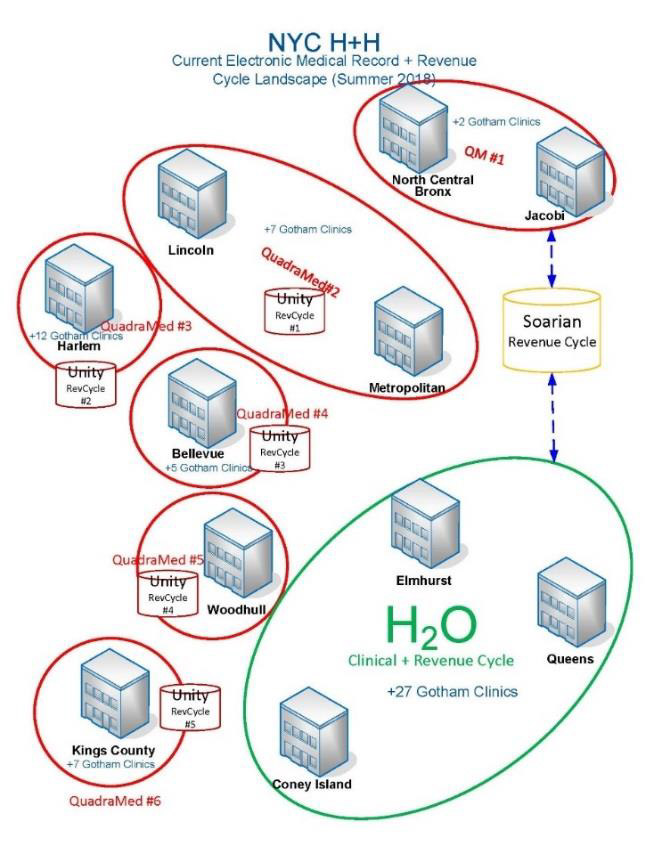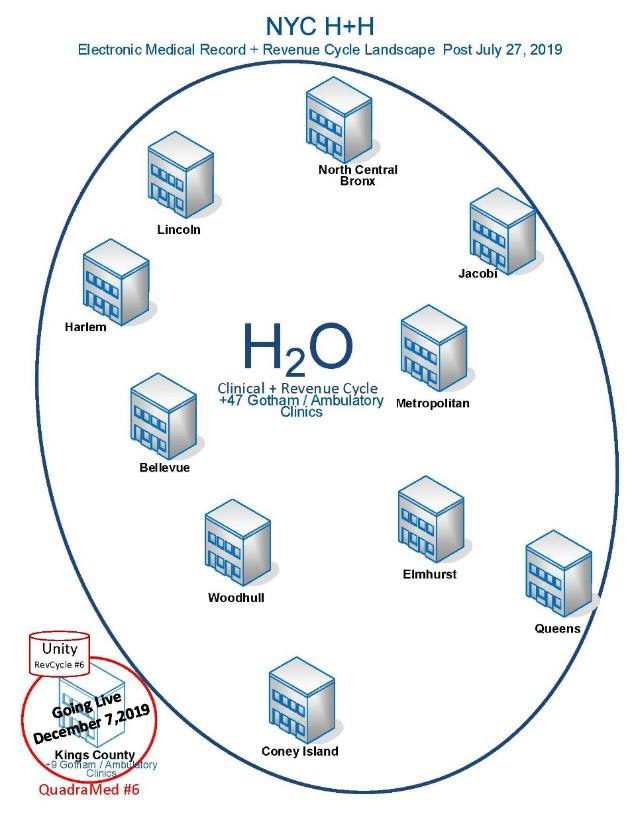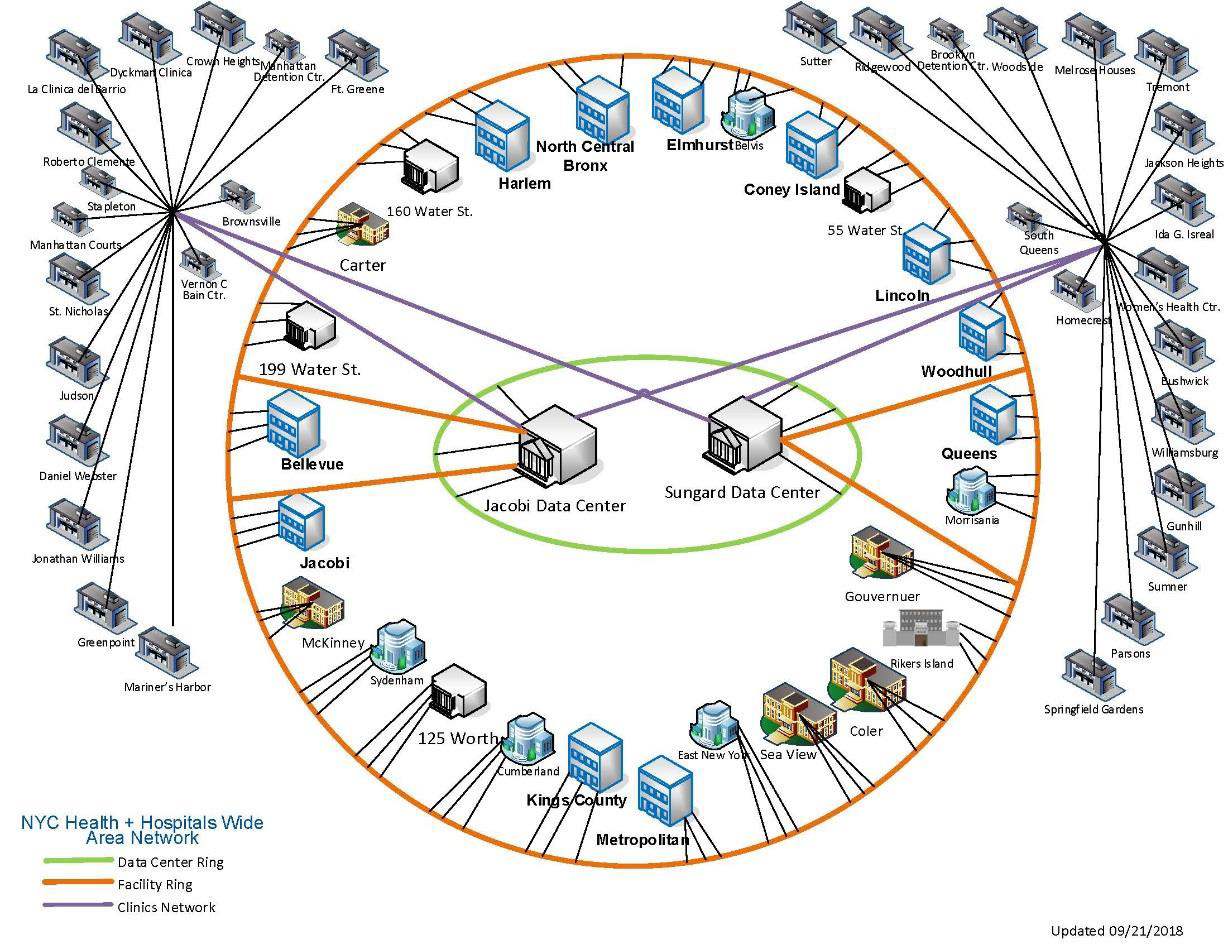Kevin Lynch, Senior Vice President and Chief Information Officer
NYC HEALTH + HOSPITALS
Wednesday, November 20, 2019
Good afternoon Chairs Rivera and Holden, and members of the Committee on Hospitals and the Committee on Technology. I am Kevin Lynch, Senior Vice President and Chief Information Officer for NYC Health + Hospitals (Health + Hospitals). I’m joined by Michael Bouton, Chief Medical Information Officer at Health + Hospitals, and Chris Roker, Chief Executive Officer at NYC Health + Hospitals/Queens Hospital Center. Thank you for the opportunity to update you on Health + Hospitals implementation of its electronic health records (EHRs).
EHR systems have transformed the health care system from a mostly paper-based industry to one that utilizes technology to assist clinicians in delivering high quality care to their patients. In 2009, the Health Information Technology for Economic and Clinical Health (HITECH) Act was signed into law to incentivize providers – hospitals and physicians – to adopt EHR systems. HITECH requires providers to adopt EHRs and utilize them in a “meaningful” way, which includes using EHRs to reduce medical errors and contain costs.
Our system has seen significant improvements in meeting the “meaningful use” measures with the vast majority of providers meeting all the criteria/requirementsi as an eligible provider for meaningful use this year for the first time. Physician notes in the United States are greater than three times longer than notes in Europe and we are not immune to this national challenge. We strive to free physicians from the EHR to spend more time in direct, uninterrupted contact with their patients. We have significant work to do in this space, but have also made significant improvements.
We have also made the EHR more useful to providers. Providers can see their patient’s record not only within all our Health + Hospitals facilities, but also their records from other facilities. This leads to a reduction in redundant testing, decreased cost, and improved safety.
Today, we are a safer, more efficient system than we were last year. And next year we will be able to say that again.
Health + Hospitals has embraced EHRs as a critical step in the health system’s transformation and New York City’s plan to guarantee health coverage to all New Yorkers. Our principal Epic EHR, which has been named H2O (Health + Hospitals Online), connects the system’s vast network of hospitals, emergency rooms, primary and specialty ambulatory outpatient services, as well as the home care agency into one unified electronic health record and finance information system to assist clinicians to deliver safe and efficient care. Additionally, H20 allows patients easy access to their medical records and the ability to communicate with their provider through a secure patient-portal called My Chart.
Health + Hospitals is the nation’s largest public health system with 11 acute care facilities, a single long term acute care hospital, 56 Gotham Health/ambulatory locations — the largest network of federally-qualified health centers in the nation, five post-acute care facilities, and over 10 correctional health locations.
Figure 1

Until October 2018, we had eight separate versions of QuadraMed EHR for clinical documentation, several Soarian, and Unity systems for revenue cycle, and three facilities on an enterprise clinical version of Epic.
Figure 2

A year later, we have 10 of 11 acute locations and 47 of 56 Gotham Health/ambulatory locations on one enterprise electronic medical record and revenue cycle system.
Figure 3

We are 16 daysii away from having an enterprise electronic medical record system deployed across all of our acute and Gotham/ambulatory locations. Currently, we have over 45,000 users; 4.8 million unique registered patients; have trained over 54,700 people; and over 97,000 courses have been completed. Our ability to capture revenue has improved significantly with a 20% increase in charge capture and $55 million in cumulative cash collection for our October 2018 go live sites;iii a 29% increase in our charge capture and $25 million cumulative cash collection for our March 2019 go live sites;iv and a 20% increase in our charge capture for our July 2019 go live sites.v In 2012, Health + Hospitals contracted with Epic as its enterprise electronic medical record system with the intention of deploying across all acute, Gotham Health/ambulatory, and post-acute care locations with the option to evaluate the capability to extend it to Correctional Health Services.
The budgeted amount was $764 million.
The project initiated in 2013 with the intent to implement a standard enterprise EHR throughout Health + Hospitals for clinical care and documentation. Soarian would be used for revenue cycle and Epic would be used clinical care and documentation. The timeline for completion was December 2018.
In 2016, the first facilities to go live (NYC Health + Hospitals Queens Hospital Center & NYC Health + Hospitals/Elmhurst Hospital Center) had challenges with the training, and adoption, along with the revenue cycle / clinical interface. In 2017 after the third facility (NYC Health + Hospitals/Coney Island Hospital Center) went live with Epic for clinical care and documentation and Soarian for revenue cycle, it was decided to utilize Epic for both clinical care and revenue cycle. The decision was based on lessons learned from working with Epic’s electronic medical record, which demonstrated the potential of the integrated system as well as the limitations of working with a differently designed revenue cycle product. This change added $289 million to the project which now totals $1.05 billion and extended the project timeline to late 2020.
In 2018, we accelerated the implementation timeline in order to complete at acute/Gotham Health/ambulatory sites by calendar year end 2019. We also decided to utilize separate EHRs for both Post-Acute Care and Correctional Health Services based upon the immediate need to get off legacy clinical products. Our current version of Epic, at that time, was not a mature model for Post-Acute Care and Correctional Health Services. The decision was to bring up separate Post-Acute Care and Correctional Health Services EHRs in a timely fashion and to allow appropriate access to the systems that support both clinical and financial benefits with the intent to eventually integrate the data as appropriate. Both Post-Acute Care and Correctional Health Services have successfully implemented their systems (Point Click Care and Fusion, respectively) over the spring/summer/fall of 2019.
Integration options include direct interfaces, sharing discrete data through standard formats such as Continuity of Care Documents and Clinical Document Architecture. Other integration platforms include Epic Care Everywhere, Epic Care Quality, Epic Care Connect, and Epic Care Link along with Health Information Exchanges such as New York Care Information Gateway (NYCIG) and Healthix.
Epic Care Everywhere, which provides the ability to share individual patient information, with their consent, when they are seen at other Epic facilities is the platform that we are advancing with immediately and we will continue to evolve our integration/interoperability throughout 2020.
Epic Care Quality, is a platform to share patient health care information, with their consent, to non-Epic sites.
Epic Care Link supports external providers to securely log in to Health + Hospitals Epic application to perform simple tasks such as placing referrals for their patients who are currently being treated at Health + Hospital facilities. Epic Care Link replaces the HHC Advantage program.
Epic Care Connect will allow the extension of Health + Hospitals Epic application to external providers and/or hospitals. Health + Hospitals currently has an initiative to securely extend the ambulatory application suite to multiple physician partners in the local community.
Figure 4

Featured Benefits and New Functionality of H2O (Epic) EHR
- Patient & Provider Partnership Focused
- H2O MyChart is our online patient portal that allows patients to access personal health information by using a computer, tablet, or smartphone, to view their test results, communicate directly and securely with their healthcare provider, request prescription refills, and make/reschedule appointments, all which enable our patients to better track their care.
- H2O reduces patient paperwork, there are fewer and shorter forms to complete; it moves information accurately into the hands of caregivers who need it; and, it enables providers to make the best possible decisions, especially in a crisis and supports provider patient care coordination.
- H2O provides an alert to their provider if another provider has already prescribed a similar or contraindicated medication, saving them from risks and costs of taking ineffective medications and it reduces unnecessary tests and procedures, which can result in higher healthcare costs.
- H2O offers a single patient record shared across all facilities. For example, a provider treating a patient at NYC Health + Hospitals/Bellevue Hospital Center can see all care provided to that same patient if previously seen at NYC Health + Hospitals/Coney Island Hospital or any other Health + Hospitals facility.
- Improving Health Quality & Safety
- An early alert system and real-time reports can help clinicians improve the identification of patients with sepsis, in both inpatient and emergency department settings.
- The electronic health record system also supports hospitals’ ability to prevent medical errors. One such example is the use of bar-coded medication administration across the inpatient care environment. This process supports administration of the right medication, to the right patient, at the right time with the right dose.
- H2O has also incorporated best practice alerts to remind providers of the appropriate screenings and immunizations that may be due or the type of infection prevention protocol to follow.
- Data Governance , Reporting & Analysis
- In H2O, the single enterprise patient record drives a single source of data collection, leveraging both clinical and financial data from one system.
- H2O provides industry standard enterprise operational, clinical, revenue and regulatory reports with the ability to develop and maintain Health + Hospital specific reporting as needed.
- Privacy & Security
- Health + Hospitals maintains HIPAA (Health Insurance Portability and Accountability Act of 1996) compliance.
- To share patient health care data, the patient must opt-in and consent to sharing of their data, or there must be a legal exception for which the sharing of such data is authorized.
- H2O report writing supports Break/Touch the Glass audits.
- Health + Hospitals maintains the security measures to protect our data in use, transit, and storage which supports confidentiality, data integrity and appropriate availability.
- IT infrastructure logistics addressed Data Center refresh, Wide Area Network Circuits, new network cabling for required devices including workstations, Wi-Fi for computers-on wheels, laboratory label printers, facility based network closet construction needs for power and cooling. Consolidating and reducing number of network printers and the need to print physical paper.
- New operational devices with standard workflows were implemented to support patient registration best practices including:
- Cameras to take & link patient photo to their health record for patient safety;
- Electronic signature pads to capture consents and link them to the patient health record;
- Bar coded label printers to replace embossed cards for patient identification;
- Document scanners to link insurance card, ID card, and additional pertinent patient document ( e.g. Health Care Proxy) to the patient record;
- Credit card swipe machines to collect co-payments at the registration desk; and
- Patient facing kiosks enabling self-check-in and update demographic information for Women’s Health Services to start with an expansion in 2020.
- Supporting and aligning strategic health system prioritized initiatives;
- Ongoing sustainable training and development of staff; and
- Augment and optimize functionality based on collective clinical and operational business owner’s direction.
The foundation of our IT Security program is built upon the NIST (National Institute of Standards and Technology) Cybersecurity Framework. Our information security policies and standards are aligned with HIPAA Operating Procedures and direct the implementation of security controls across our enterprise. Our risk management program conducts ongoing assessments that includes Compliance, Counsel, Supply Chain, and independent expert vendor to conduct risk assessment and network penetration testing. Information security and awareness workforce training is required annually and is supplemented with monthly newsletters, screen savers, and quarterly phishing exercises that reinforce security best practices.
Health + Hospitals has implemented a layered security platform including intrusion prevention systems (IPS), and industry standard antivirus tools that protect our circuits, switches, servers and endpoint devices. We encrypt all endpoint devices including hard drives and USB devices and secure our mobile devices. We access H2O from a virtual desktop (VDI) to ensure that electronic protected health information (ePHI) will not be exposed to a local PC.
New IT Infrastructure, Technical and Devices
Figure 5

Future Path /Next Steps
Our EHR serves as foundational tool to drive an enterprise, standard, integrated health system.
Thank you for allowing me to testify before you today. I look forward to taking your questions.
i Meeting all the requirements of the HITECH Act and subsequent rules. There are 8 objectives and all underlying sub-objectives for a total of over 20 defined measures such as using computer order entry, performing medication conciliation, and patients engaging with a patient portal.
ii In December 2019, Kings County and East New York and associated off-site clinics will go live early.
iii In October 2018, Epic went live at Woodhull and over 20 Gotham clinics, including Cumberland Diagnostic and Treatment Center along with the retrofit to include revenue cycle modules at Coney Island, Queens and Elmhurst hospitals.
iv In March 2019, Epic went live at Bellevue, Harlem, and another 18 Gotham clinics including Gouverneur and Sydenham Diagnostic and Treatment Centers.
v In July 2019, Epic went live at Metropolitan, Lincoln, Belvis and Morrisania Diagnostic and Treatment Centers, and associated off-site clinics.

